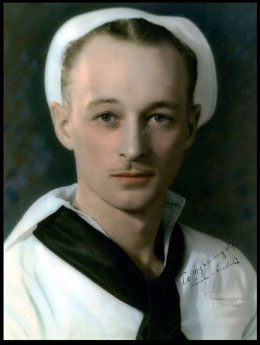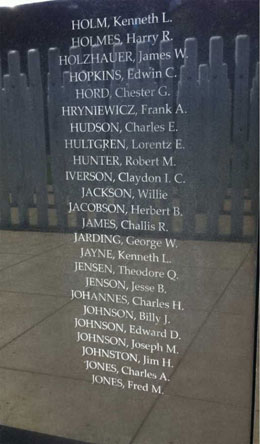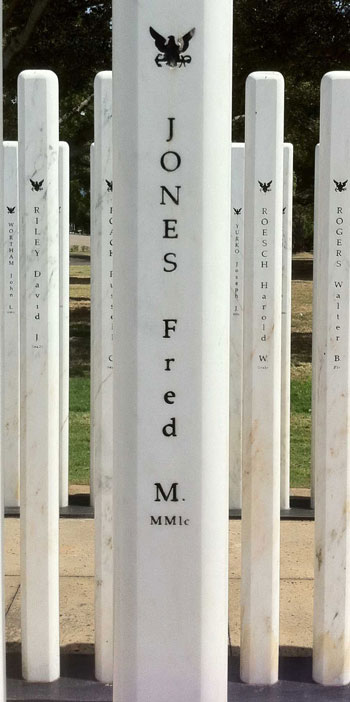

Fred was married and the father of two young children, Leilani and Jon, ages about 7 and 5 respectively.
An attempt was made to salvage the ship, in 1942 it was pulled from the water by more than 20 electric street car motors connected by cables to the hull of the ship. The ship was finally floated in early November 1943, and the bodies of the 429 casualties were recovered for burial. Fred's body was among the 389 unknowns interred in the Halawa and Nu’uanu Cemeteries in Hawaii. The USS Oklahoma went down again, this time for the last time. The ship was under tow to Oakland, California when it developed a list and sank at sea. She rests somewhere on the bottom, 540 miles northeast of the Hawaiian Islands.
As part of its global mission, in September, 1947, the AGRS disinterred the USS Oklahoma remains from the two cemeteries and transferred them to the Central Identification Laboratory at Schofield Barracks in Hawaii. Those efforts yielded individual identifications for only 35 men, 32 Sailors and three Marines, from the remains believed to be those of the USS Oklahoma’s missing crew members, leaving a total of 394 from the ship still unaccounted for.
After AGRS officials determined that no other identifications could be made, in 1950, the remains associated with the USS Oklahoma were placed in 62 caskets and buried as Unknowns in 46 plots at the National Memorial Cemetery of the Pacific, commonly called “the Punchbowl,” in Honolulu.
The USS Oklahoma Unknowns lay undisturbed for nearly 50 years until Ray Emory, a Pearl Harbor survivor, began to conduct some research at the request of the family of an unaccounted for USS Oklahoma Sailor. Emory found records that indicated at least one set of the USS Oklahoma remains could be individually identified if the remains could be disinterred for a thorough forensic examination.
In 2003, one of the 62 caskets containing remains from the USS Oklahoma was disinterred from the Punchbowl to conduct analysis on the remains to test Emory’s assertions. The remains from the single casket were accessioned into what was known then as the U.S. Army Central Identification Laboratory, Hawaii. The staff analyzed the remains using the latest technology and concluded that they came from more than 100 individuals, giving a good indication of the extent that remains from the ship were comingled during previous handling and identification attempts.
The laboratory made its first individual identification from the remains in that single casket in 2008, ultimately identifying a total of five Sailors from that casket between 2008 and 2010.
In 2012, based on the information and experience gained through those six identifications, the Joint POW/MIA Accounting Command, the organization charged with running the Hawaii lab at that time, put forth a proposal to disinter the remaining 61 caskets of USS Oklahoma unknowns in hopes of finding the 377 Sailors and 11 Marines who remained unaccounted for.
In 2015, Department of Defense officials issued the orders allowing a phased disinterment of the remaining USS Oklahoma caskets from the Punchbowl. On November 10, 2015, the last of the USS Oklahoma unknown caskets was removed from the cemetery, thanks to a partnership between DPAA and the Department of Veterans Affairs. Its contents, along with the remains from the other 60 caskets and the unidentified material from the initial casket, were eventually transferred to the DPAA laboratory at Offutt Air Base. All of the material was accessioned into the lab under a unifying moniker: The DPAA USS Oklahoma Project.
To help get the project proposal approved, Navy POW/MIA Branch pushed to contact family members to provide DNA reference samples, resulting in nearly 85% of the ship’s missing personnel having a sample in the vault before the identification processing began.
In 2017 the remains of Fred Jones were identified. He was returned home and buried next to his sister in Port Huron, Michigan. (Click on the photo of the news article to make it larger.) His wife had remarried and died in 2007, his son Jon had died in 1989. I was unable to determine whether Leilani was alive.
On March 8, 2109 the 200th identification was made of those lost on the USS Oklahoma.
Fred's memorial at USS Oklahoma Memorial
Fred's memorial at Honolulu Memorial, aka Courts of the Missing, WWII
Fred's memorial at Lakeside Cemetery, Port Huron, MI
The number of deaths on the USS Oklahoma,was second only to the 1,177 men who perished aboard the USS Arizona. For almost 60 years, there was no memorial to commemorate the men or their ship. Part of the Oklahoma sat submerged near Ford Island while many of her crew lay in unidentified mass graves. At the Punchbowl cemetery, where countless young servicemen rest, no one knew exactly where the Oklahoma crew was buried. Beginning in 2000, USS Oklahoma survivors, members of the USS Oklahoma Memorial at Pearl Harbor Committee, and hundreds of others came together to create the memorial. In 2006, President Bush officially signed the memorial into law as a national memorial entrusted to the National Park Service.


On December 7th, 2007, the memorial was formally dedicated as an enduring reminder of the Oklahoma and her crew. The memorial’s black granite walls suggest the once formidable hull of the Oklahoma while the white marble standards represent its lost sailors and Marines. Each perfectly aligned marble standard symbolizes an individual in white dress uniform, inspired from the naval tradition of ‘manning the rails.’ The marble standards of this memorial stand perfectly straight, ‘manning the rails’ of the Oklahoma, forever.